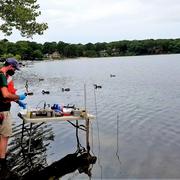Chesapeake Bay Activities
Home
The Chesapeake Bay is our Nation’s largest estuary and provides over $100 billion in annual economic value. The USGS works with Federal, State, local, and academic partners to provide research and monitoring and to communicate results to inform management for the Chesapeake and other important landscapes across the Nation. See our Science page to learn about our themes and topics being addressed.
Data-sharing agreement renewed to evaluate conservations practices
USGS and NRCS have a mutual interest in meeting the goals of the Chesapeake Bay Watershed Agreement, and in determining the benefits and challenges of agricultural conservation practices on water-quality patterns
Find out moreNew Review of Sediment Science Informs Choices of Management Actions
The USGS conducted a synthesis on the state-of-the-art science of sediment dynamics for the Chesapeake Bay watershed to inform restoration efforts. The synthesis reviewed and summarized multiple aspects of sediment.
Read moreQuick Links
Learn more about USGS science activities in the Bay from our Science Strategy. Additional summaries of the USGS Chesapeake Bay Activities are available in the science topics section.
Science Summaries, Features, and Videos
News
Chesapeake Bay Activities Newsletter November-December 2020
The USGS provides research and monitoring to better understand and restore the Chesapeake Bay and its watershed. Our technical reports and journal articles, which we translate into science summaries, provide the findings used by federal, state, and local decisionmakers to inform restoration and conservation decisions. Here are some recent highlights.
‘Forever chemicals’ found in Chesapeake seafood and Maryland drinking water
Bay Journal — By Timothy Wheeler — November 17, 2020
‘eDNA’ reveals what’s swimming in the water
Bay Journal — By Ad Crable — November 11, 2020
Publications
Assessing native fish restoration potential in Catoctin Mountain Park
Biological conservation is a fundamental purpose of the National Park system, and Catoctin Mountain Park (CATO) supports high-quality habitat for native fishes in the headwaters of the Chesapeake Bay watershed in eastern North America. However, native Blue Ridge sculpin (Cottus caeruleomentum) have been extirpated in Big Hunting Creek above...
Hitt, Nathaniel P.; Kessler, Karmann G.; Kelly, Zachary A.; Rogers, Karli M.; Macmillan, Hannah E.; Walsh, Heather L.Spatial and temporal patterns in streamflow, water chemistry, and aquatic macroinvertebrates of selected streams in Fairfax County, Virginia, 2007–18
Urbanization substantially alters the landscape in ways that can impact stream hydrology, water chemistry, and the health of aquatic communities. Stormwater best management practices (BMPs) are the primary tools used to mitigate the effects of urban stressors such as increased runoff, decreased baseflow, and increased nutrient and sediment...
Porter, Aaron J.; Webber, James S.; Witt, Jonathan W.; Jastram, John D.Meeting the challenge: U.S. Geological Survey North Atlantic and Appalachian Region fiscal year 2020 in review
The utilization, preservation, and conservation of the Nation’s resources requires well-informed management decisions. The North Atlantic and Appalachian Region (NAAR) of the U.S. Geological Survey (USGS) supports science-based decision making for Federal, State, and local policymakers to meet the challenges of today and into the future. The...









